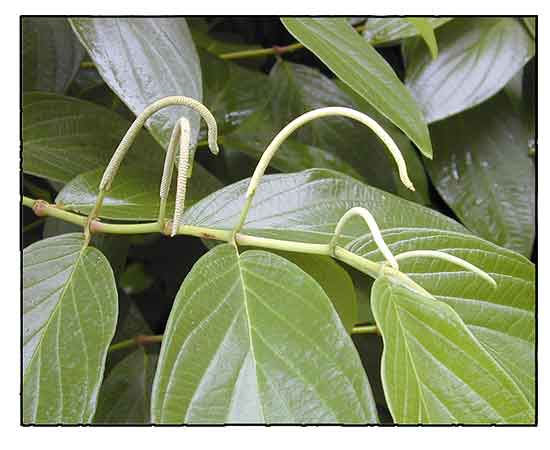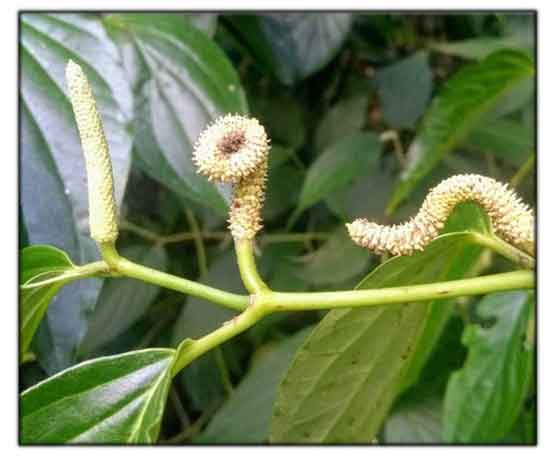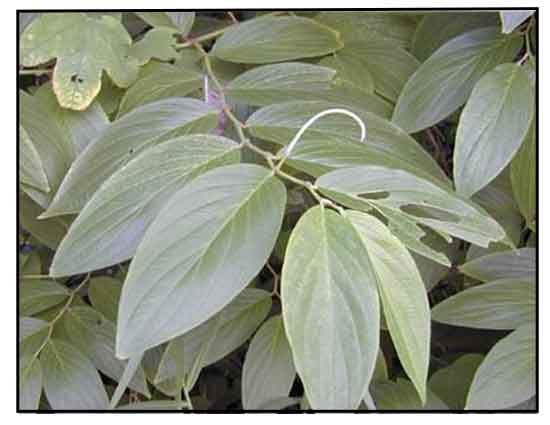 Gen info Gen info
- The genus Piper contains more than 2,000 species of shrubs, climbers, and small trees of pantropical distribution. It contains a number of invasive species, of which P. aduncum is considered the most invasive.
- Piper aduncum was first described in 1753 by Linnaeus and published in Species Plantarum.
- Etymology: According to legends, a wounded Spanish soldier named Matico "discovered" the plant, presumably learning from local tribes that applying leaves to his wounds would stop the bleeding, and was thereafter called "Matico" or "soldier's herb". (4)
- Historical snippet: In 1839, it was introduced into United States and European medicine by a Liverpool physician as a styptic and astringent for wounds. (4)
 Botany Botany
• Piper aduncum is a shrub or small tree up to 7 m tall and 10 cm or more in stem diameter, with short silt roots and medium-hard, brittle wood; foliage and twigs aromatic, which can grow as individual plants or in thickets. Branches are erect, but with drooping twigs and swollen, purplish nodes. Leaves alternate, distichous, elliptic, 12-22 cm long, shortly petiolate; lamina scabrid above, with sunken nerves, softly hairy beneath. Inflorescence a leaf-opposed, curved spike on a 12-17 cm peduncle, white to pale yellow, turning green with maturity. Flowers crowded in regular transverse ranks. Perianth absent; usually 4 stamens. Fruit a 1-seeded berry, compressed into grayish, wormlike spikes. Seeds brown to black, 0.7 -1.25 mm long, compressed, with a reticulate surface. (ISSG, 2016) (3)
Distribution
- Introduced.
- Widely naturalized, invasive. (2)
- In Mindanao (Cotobato, Davao del Sur, Zamboanga del Sur), Panay. (2)
- Native to
Argentina Northeast, Argentina Northwest, Belize, Bolivia, Brazil North, Brazil Northeast, Brazil South, Brazil Southeast, Brazil West-Central, Colombia, Costa Rica, Dominican Republic, El Salvador, French Guiana, Guatemala, Guyana, Haiti, Honduras, Jamaica, Leeward Is., Mexico Central, Mexico Gulf, Mexico Northeast, Mexico Northwest, Mexico Southeast, Mexico Southwest, Nicaragua, Panamá, Paraguay, Peru, Puerto Rico, Suriname, Trinidad-Tobago, Venezuela, Windward Is. (1)
Constituents
- Essential oil main compounds of Piper aduncum were identified as myristicin 30.03%, aromadendrene 9.20%, dillapiole 8.43%, α-serinene 7.31%, tridecane 6.26%, γ-elemene 4.58% and o-cymene 4.20%. (see study below) (8)
- LC-MS-ES analysis of ethanol extract of leaves identified gallic acid, catechin, chlorogenic acid, epicatechin, rutin, quercitrin, phloridzin, quercetin, and phloretin.
(see study below) (13)
- GC-MS analysis of P. aduncum leaves
for volatile constituents yielded dill apiole (43.3%), ß-caryophyllene (8.2%), piperitione (6.7%) and α-humulene (5.1%). (16)
Properties
- The tree has a characteristic smell of pepper.
- Studies have suggested biopesticidal, cytoprotective, anti-inflammatory, insecticidal, acaricidal, anti-parasitic, antioxidant, bactericidal, anti-Leishmanial, anthelmintic, anticancer, antifungal properties.
Parts used
Leaves.
 Uses Uses
Edibility
- Fruits used as condiment and for flavoring cocoa. Sometimes used as substitute for long pepper.
Folkloric
- Poultice of leaves used for snake bites.
- In the Amazon Rainforest, tribes used leaves as antiseptic. In Peru, used for stopping hemorrhages and treatment of ulcers.
- In various fold medicine used as anti-inflammatory, for wound healing, rheumatic afflictions, diarrhea, and as antiseptic.
- In Peruvian ethnobotany used for treatment of diarrhea. In Columbia, used for treatment of haemostasis and dysentery.
- In Papua New Guinea, the bark and leaves are used to dress fresh knife, axe, or spear wounds; new leaves are used as bandages. (22)
Others
- Wood: Dried wood and branches used as firewood, fencing, and temporary construction. However, the wood easily rots away with long-term exposure to moisture.
- Construction: Stems used as support of palm thatch roofs.
- Veterinary: Macerated leaves smeared on skin of affected dogs to combat scabies.
Studies
• Antioxidant / Cytoprotective against Sodium Fluoride Toxicity / Leaves: Study evaluated the cytoprotective and antioxidant effects of methanolic extract of Piper aduncum leaves in Mus musculus administered with sodium fluoride (NaF). Comet assay showed significant reduction of NaF-induced damage on erythrocytes depending on different extract concentrations. Results suggest P. aduncum leaves have cytoprotective and antioxidant activity against NaF. (6)
• Biopesticide / insecticidal, Acaricidal, Antiparasitic / Essential Oil: Study analyzed the existing information on P. aduncum essential oil properties as insecticide, acaricide, and antiparasitic. The insecticidal effects are highly promising, with optimal results against malaria vector Aedes aegypti, with LC50 range between 57 and 200 µg/mL> Acaricidal activity against Tetranychus urticae showed an LC50 range between 5.83 and 7.17 µg/mL. Antiparasitic activity was found on Leishmania amazonensis, with antipromastigote activity between 23.8 and 25.9 µg/mL. Review highlights the potential of P. aduncum essential oil as a biopesticide. (7)
• Cytotoxicity Study / Molecular Confirmation: Molecular confirmation study revealed the "Lunas" species was a member of Piperaceae and not Rutaceae. Phylogeny of Asian Piper using ITS sequences identified Lunas-buyo as Piper aduncum. Cytotoxic activity test using trypan blue exclusion method against normal lymphocytes from human blood showed mild toxicity (88.3% viable cells) when subjected to 1000 µg/ml of stem ethanolic extracts. (8)
• Effect of Postharvest UV-C Irradiation on Essential Oil / Dillapiole Content / Leaves: Study evaluated the post-harvest impact of UV-C irradiation on metabolic profile of EOs from fresh leaves. The relative percentage of arylpropanoid dillapiole, a compound of high commercial value, increased significantly by threefold after exposure to UV-C irradiation, ranging from 26.81% (not irradiated) to 95.60% (360 min of irradiation). Results suggest exposure of freshly harvested leaves to UV-C may be a promising technique for enriching the dillapiloe content, with potential commercial applications and large-scale industry use. (9)
• Anti-Inflammatory against Snake Venom Phospholipase A2: Study evaluated the in vitro inhibitory activity of Plantago major "llanten" and Piper aduncum "matico" extracts on phospholipase A2 (PLA2) from venom of snake Lachesis muta muta. Phenols, flavonoids, tannins and saponins were identified in P. aduncum. P. aduncum total extract showed inhibition value of 86.9% while fractions (MF-1-3) showed inhibition rates of 34.3%, 67.1%, and 54.9%, respectively. Statistical analysis showed significant differences in inhibition of PLA2 (p=0.009) by the extracts. (10)
• Cytotoxicity to Brown Stink Bug (Euschistus heros) / Essential Oil: Study evaluated the cytological changes in the salivary glands, fat body and midgut of E. heros (Heteroptera: Pentatomidae) exposed to different concentrations of essential oil of Piper aduncum. Essential oil main compounds were identified as myristicin 30.03%, aromadendrene 9.20%, dillapiole 8.43%, α-serinene 7.31%, tridecane 6.26%, γ-elemene 4.58% and o-cymene 4.20%. The EO was toxic for E. heros with LD50 of 36.23 mg per insect and LD90 of 50.42 mg. Cytological changes in fat body cells included tissue disruption, increase in mitochondria population, and glycogen and lipid depletion. Results suggest P. aduncum EO causes fat body cellular stress, which may compromise some physiological processes essential for insect survival. (11)
• Synergistic Insecticidal Potential: Study evaluated the synergy and response homogeneity of Spodoptera frugiperda larvae population to essential oil of Piper aduncum in combination with insecticides formulated with two active ingredients in ready mixtures: Imidacloprid/beta- Cyfluthrin, Teflubenzuron/alpha-Cypermethrin and Thiamethoxam/lambda-Cyhalothrin, compared with piperonyl butoxide (PBO positive controls). Results showed in topical contact there was significant potentiation only for the ready mixtures of Teflubenzuron/alpha-Cypermethrin insecticides when combined with the essential oil. Results suggest the EO has potential as an alternative to PBO for synergistic effect. (12)
• Antioxidant / Leaves: Study evaluated ethanol extracts of P. aduncum leaves for polyphenol content and antioxidant capacity. LC-MS-ES analysis of ethanol extract of leaves identified gallic acid, catechin, chlorogenic acid, epicatechin, rutin, quercitrin, phloridzin, quercetin, and phloretin. The ethanol extract exhibited DPPH IC50 values of 85-220 µg/mL, which correlates with values for green tea (100-300 µg/ml) and slightly lower for black tea (200-800 µg/ml). The different polyphenols may be responsible for the antioxidant activity. (13)
• Antibacterial against MDR-Strains / Oil and Dillapiole: Study evaluated the bactericidal activity of essential oil and dillapiole from P. aduncum against standard and multi-drug resistant strains of Staphylococcus spp. The EO showed antimicrobial action against the strains, but better results were obtained from standard strains of S. epidermis and S. aureus, with MIC of 250 and 500 µg/mL, respectively. Dillapiolle was less effective than the EO. However, when dillapiole was combined with myristicin, an oil component, there was synergistic action and increased bactericidal activity. (14)
• Anti-Leishmanial / DMC / Inflorescences: 2'.6'-Dihydroxy-4'-methoxychalcone (DMC), purified from dichloromethane extract of Piper aduncum inflorescences showed significant in vitro activity against promastigotes and intracellular amastigotes of Leishmania amazonensis, with 50% effective doses of 0.5 and 25 µg/ml, respectively. The inhibitory effect on amastigotes is apparently a direct effect on the parasites. Ultrastructural studies showed that in the presence of DMC the mitochondria of promastigotes were enlarged and disorganized. Various observations suggest DMC is selectively toxic to the parasites. The simple structure may serve as a lead compound for the synthesis of novel antileishmanial drugs. (15)
• Toxicological Study: Study evaluated preclinical toxicological tests of ethanolic extract of P. aduncum at concentrations of 1, 10, 50, and 100µg/ml, using Artemia salina assay, Allium cepa root alterations, and human erythrocyte osmotic frailty test. The concentrations of crude extract showed no effect on cell membrane, but demonstrated toxic potential in cell development. (17)
• Protective against DMBA-Induced Breast Cancer: Study evaluated the protective effect of Piper aduncum capsule on DMBA (dimethylbenz[α]anthracene)-induced breast cancer in rats. Mammary carcinogenesis was induced in female Holtzman rats by a single subcutaneous injection of DMBA. Oral administration of P. aduncum capsule lowered adenocarcinoma and lymph node metastases incidence. Pulmonary metastases was significantly lower (p<0.05). C-reactive protein (CRP) level (p<0.01) and malondialdehyde level (p<0.o05) were significantly lowered. Results suggest a protective effect on DMBA-induced breast cancer in rats. (18)
• Influence of Drying on Composition and Bioactivity of EO against Aedes aegypti: Study evaluated the chemical composition of essential oil from leaves and inflorescences of Piper aduncum and the effect of drying process on yield, chemical composition and larvicide potential against Ae. aegypti. The drying process increased the extractive process compared to the fresh one. The amount of monoterpenes was lower in the dehydrated samples, due to volatilization. Major constituents were dillapiole and safrole. Despite differences in oil composition, the larvicidal bioactivity remained in promising concentrations, attributed to predominance of substances with known insecticidal potential, such as eupatoriochromene and germacrene D. (19)
• Antifungal against Candida albicans / Leaves: Study evaluated the effect of Piper aduncum leaf ethanol extract at certain concentrations against Candida albicans growth inhibition in vitro. The P. aduncum leaf extract at 80% was most effective for C. albicans growth inhibition. (20)
• Anthelmintic against Haemonchus contortus Isolates / Dillapiole / Essential Oil: Study evaluated the anthelmintic activity of essential oil of P. aduncum in vitro on eggs and larvae of resistant and susceptible isolates of Haemonchus contortus. The EO was highly efficacious against L1 (larval development) but not against egg hatching. The activity of the species against H. contortus is likely associated with dillapiole, the major EO component. The essential oil derived from P. aduncum causes nematode toxicity via dillapiole-mediated cytochrome P450 inhibition in both isolates. (21)
• Efficacy against Adult Housefly (Musca domestica) / Leaves: Study evaluated the efficacy of P. aduncum extract for adulticidal activity against the housefly Musca domestica strains. Results showed the males of both WH)213 and Chow Kit strains were more susceptible than females. Although the commercial product Resigen® showed higher adulticidal efficacy than P. aduncum extract, constant and long-term usage of the commercial synthetic insecticide would likely result in resistance problems. The P. aduncum extract can be utilized or combined with synthetic insecticide for use in housefly control programs. (23)
• Cytotoxicity against Gastric Cancer Cell Lines / Leaves: Study evaluated the cytotoxic activity of chloroform fraction of P. aduncum methanolic extract and its effect on the cell cycle in two gastric cancer cell lines: AGS and KATO III. The extract showed cytotoxic activity, inhibiting cell growth by 50%, with IC50s of 39.23 and 87.49 µg/mL at 24 hours, and 49.47 and 64.68 µg/mL at 48 hours against AGS and KATO III cell lines, respectively. The extract contains secondary metabolites with cytotoxic activity affecting the G2/M phase of cell cycle in the two gastric cell lines, both primary and metastatic. (24)
• Essential Oil-Rich Dillapiole in Nanoemulsion for Skin Delivery: Study evaluated nanoemulsions (NE) and nanostructured lipid carriers (NLC), which are biocompatible nanostructured systems, for skin delivery of dillapiole. Addition of hydroxyethylcellulose produced hydrogel-thickened NE or NCL nanoformulations with improved viscosity and skin adherence. The formulations exhibited controlled release profile, dillapiole delivery up to the dermis, the layer of interest for anti-inflammatory potential, and low irritant potential in the chorioallantoic membrane (HET-CAM). Both hydrogels-thickened NE and NLC are promising formulations for skin delivery of P. aduncum essential oil. (25)
Availability
Wild-crafted. |

![]()



 Gen info
Gen info Botany
Botany
